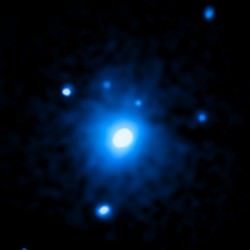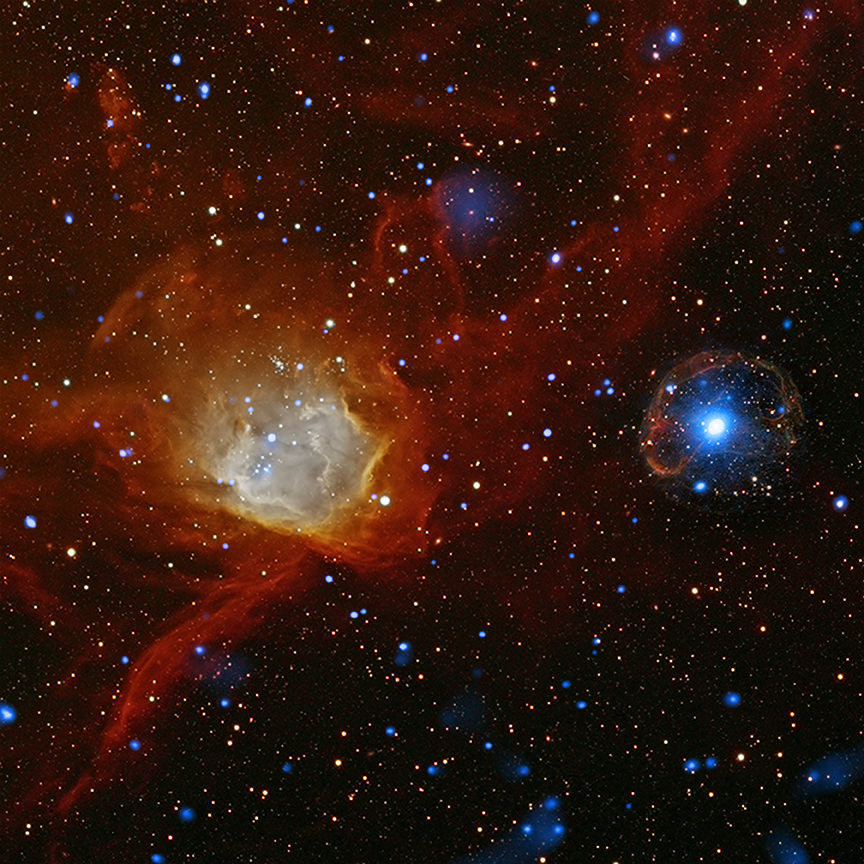[/caption]
For the first time astronomers have located a pulsar – the super-dense, spinning remains of a star – nestled within the remnants of a supernova in the Small Magellanic Cloud. The image above, a composite of x-ray and optical light data acquired by NASA’s Chandra Observatory and ESA’s XMM-Newton, shows the pulsar shining brightly on the right surrounded by the ejected outer layers of its former stellar life.
The optically-bright area on the left is a large star-forming region of dust and gas nearby SXP 1062.
A pulsar is a neutron star that emits high-energy beams of radiation from its magnetic poles. These poles are not always aligned with its axis of rotation, and so the beams swing through space as the neutron star spins. If the Earth happens to be in direct line with the beams at some point along their path, we see them as rapidly flashing radiation sources… sort of like a cosmic lighthouse on overdrive.
What’s unusual about this pulsar – called SXP 1062 – is its slow rate of rotation. Its beams spin around at a rate of about once every 18 minutes, which is downright poky for a pulsar, most of which spin several times a second.

This makes SXP 1062 one of the slowest known pulsars discovered within the Small Magellanic Cloud, a dwarf galaxy cruising alongside our own Milky Way about 200,000 light-years distant.
The supernova that presumably created the pulsar and its surrounding remnant wrapping is estimated to have taken place between 10,000 and 40,000 years ago – relatively recently, by cosmic standards. To see a young pulsar spinning so slowly is extra unusual since younger pulsars have typically been observed to have rapid rotation rates. Understanding the cause of its leisurely pace will be the next goal for SXP 1062 researchers.
Read more about SXP 1062on the Chandra photo album page.
Image credit: X-ray & Optical: NASA/CXC/Univ.Potsdam/L.Oskinova et al.


Very cool discovery! Just a little note for the readers who aren’t familiar with pulsars: The reason pulsars (usually) rotate so quickly, is because its rapid collapse from a star, with a radius of about 1 500 000 – 3 000 000km (or about 2-3 Rsun), to a neutron star, with a radius of around 15km, is much like a ballerina pulling in her arms. Basically this means that the ratio of the initial rotation period to the final one, is the same as the ratio between the initial radius and the final one.
Looking at a more typical period for a young pulsar of around 1s, it corresponds to an initial rotational period of 27-54 hours. This isn’t too extreme as only the other day universe today reported on a 10 Rsun star rotating in a mind blowing ~20 hours.
Applying this to the pulsar in this article with a period of 18 minutes (or ~1000s), we get a corresponding rotational period of ~1000 – 2000 days!!! (3 – 6 years)
Ok, that is pretty ludicrously slow. I might have made some sort of error in my calculation somewhere… I must have….
I’m just gonna crawl in my corner now and recheck my calculation…
It is my understanding that taking into account the relative youth of the pulsar(10-40 kyr), the observed slow rotation could not have been achieved by way of the pulsar spindown mechanism. A paper by Haberl et al notes SXP 1062 was “most likely born with a spin period much longer than a few tens of ms as generally adopted for an NS at birth”: http://arxiv.org/PS_cache/arxiv/pdf/1112/1112.0491v1.pdf
Another recent paper by Popov et al suggests that the pulsar may have a strong magnetic field (stronger in the past but now weakening) and that this may be a factor in the unusually slow rotation, perhaps through magnetic torque or inhibition/disruption of accretion from the Be companion: http://arxiv.org/PS_cache/arxiv/pdf/1112/1112.2507v1.pdf
The discovery paper has some additional info on the environs of SXP 1062, the supernova remnant, and the pulsar itself: http://arxiv.org/PS_cache/arxiv/pdf/1110/1110.6404v1.pdf
Yes, the slow rotation reminds of magnetars.